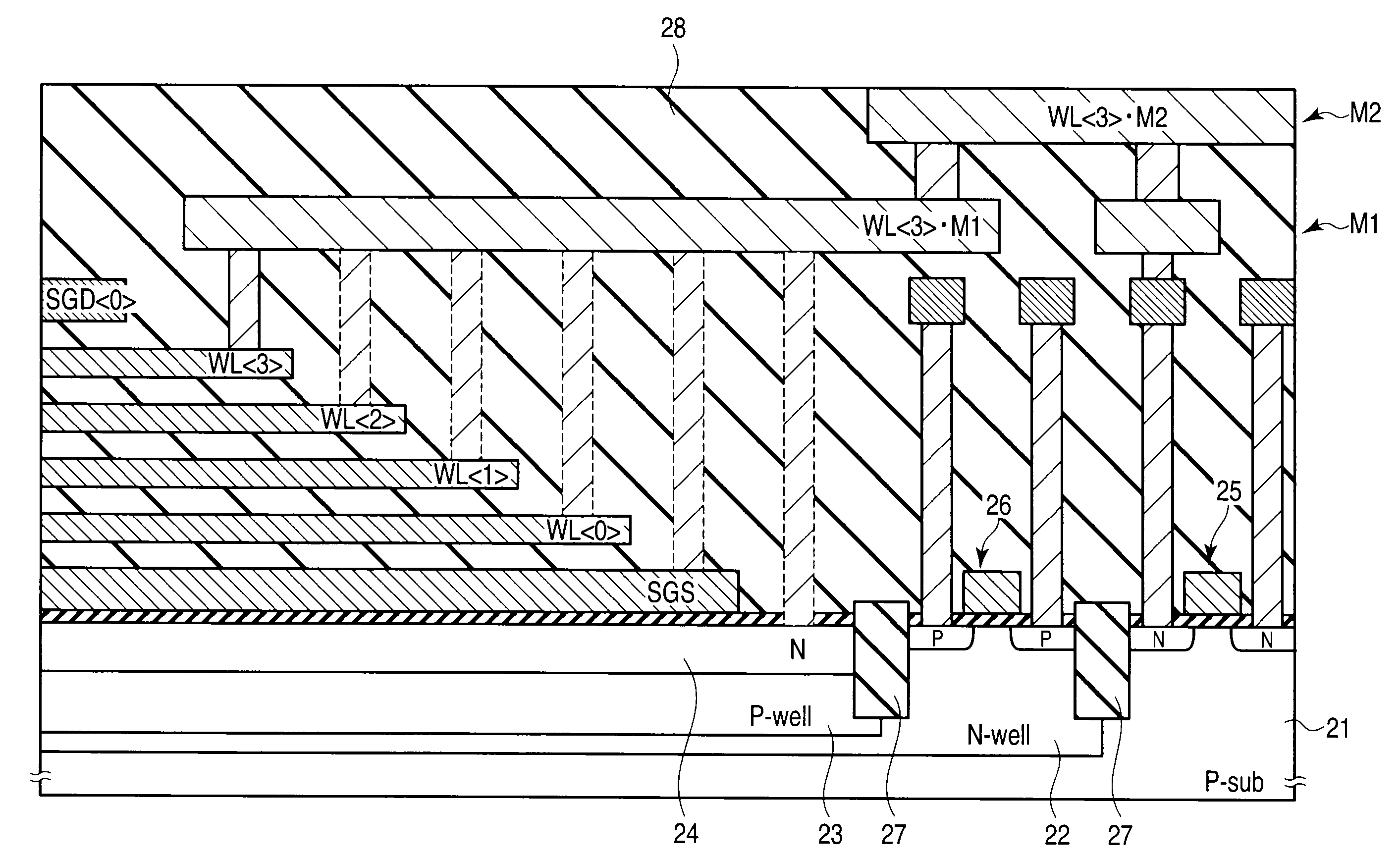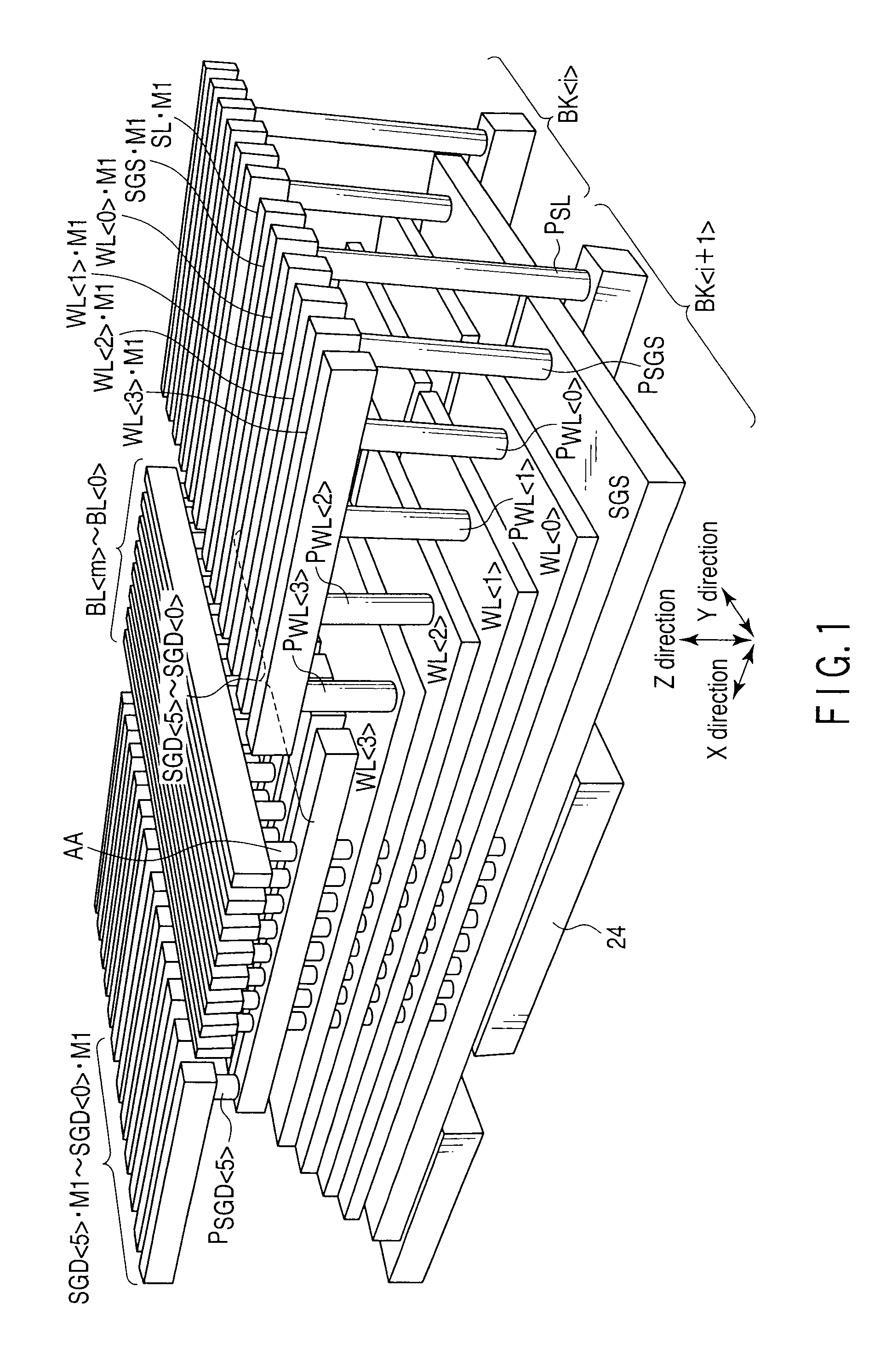Three dimensional stacked nonvolatile semiconductor memory
a nonvolatile, semiconductor technology, applied in semiconductor devices, semiconductor/solid-state device details, electrical devices, etc., can solve problems such as difficulty in stabilizing the potential of the source diffusion layer
- Summary
- Abstract
- Description
- Claims
- Application Information
AI Technical Summary
Problems solved by technology
Method used
Image
Examples
first embodiment
A. First Embodiment
[0133]FIG. 13 shows a conceptual view of a layout of a first embodiment. FIG. 14 shows a plane layout when the conceptual view of FIG. 13 is specifically arranged as a device.
[0134]The first embodiment corresponds to the block layout of FIG. 9. That is, a driver 33L connected to select gate lines SGD0>, . . . , SGD5> on a bit line side is disposed on one end (left side) of a memory cell array 31 in the X-direction as well as disposed independently of a driver 33R connected to word lines WL0>, . . . , WL3> and to a select gate line SGS on a source line side.
[0135]Each of two blocks BK, BK is comprised of at least three conductive layers, which are insulated from each other and stacked on a semiconductor substrate, bit lines BL0>, . . . , BL, which are insulated from the at least three conductive layers and disposed thereon, and active layers (columnar semiconductors) AA whose lower ends are connected to the semiconductor substrate, whose upper ends are connected to...
second embodiment
B. Second Embodiment
[0153]FIG. 15 shows a conceptual view of a layout of a second embodiment. FIG. 16 shows a plane layout when the conceptual view of FIG. 15 is specifically arranged as a device.
[0154]The second embodiment corresponds to the block layout of FIGS. 10 to 12. That is, a driver 33 (33L and 33R) disposed on one end (right side) of a memory cell array 31 in the X-direction is connected to word lines WL0>, . . . , WL3>, a select gate line SGS on a source line side, and select gate lines SGD0> . . . , SGD5> on a bit line side.
[0155]Attention must be paid to the fact that the portions, to which the layouts of FIGS. 15 and 16 are applied as they are, are limited to the portion between the memory cell array 31L and the driver 33L of FIG. 11 and to the portion between the memory cell array 31L and the driver 33 of FIG. 12.
[0156]The layouts, which are obtained by reversing the layouts of FIGS. 15 and 16 in a right to left direction, are applied to the remaining portions between...
first modification
A. First Modification
[0193]FIG. 24 shows a layout of a shunt area according to a first modification. FIG. 25 is a sectional view taken along line XXV-XXV of FIG. 24, and FIG. 26 is a sectional view taken along line XXVI-XXVI of FIG. 24.
[0194]The first modification has a feature in that a common source line STL•common is disposed above bit lines BL0>, . . . , BL and source lines STL and connected to the source lines STL.
[0195]Although the first modification is arranged based on the second embodiment (FIGS. 15 and 16), it can be also applied to the first embodiment (FIGS. 13 and 14) as a matter of course.
[0196]The common source line STL•common, which is connected to the source lines STL, is disposed above the bit lines BL0>, . . . , BL and the source lines STL. A layout of the common source line STL•common is not particularly limited. For example, the common source line STL•common may be formed flat on a memory cell array 31 or may be a conductive wire having a width larger than those...
PUM
 Login to View More
Login to View More Abstract
Description
Claims
Application Information
 Login to View More
Login to View More - R&D
- Intellectual Property
- Life Sciences
- Materials
- Tech Scout
- Unparalleled Data Quality
- Higher Quality Content
- 60% Fewer Hallucinations
Browse by: Latest US Patents, China's latest patents, Technical Efficacy Thesaurus, Application Domain, Technology Topic, Popular Technical Reports.
© 2025 PatSnap. All rights reserved.Legal|Privacy policy|Modern Slavery Act Transparency Statement|Sitemap|About US| Contact US: help@patsnap.com



